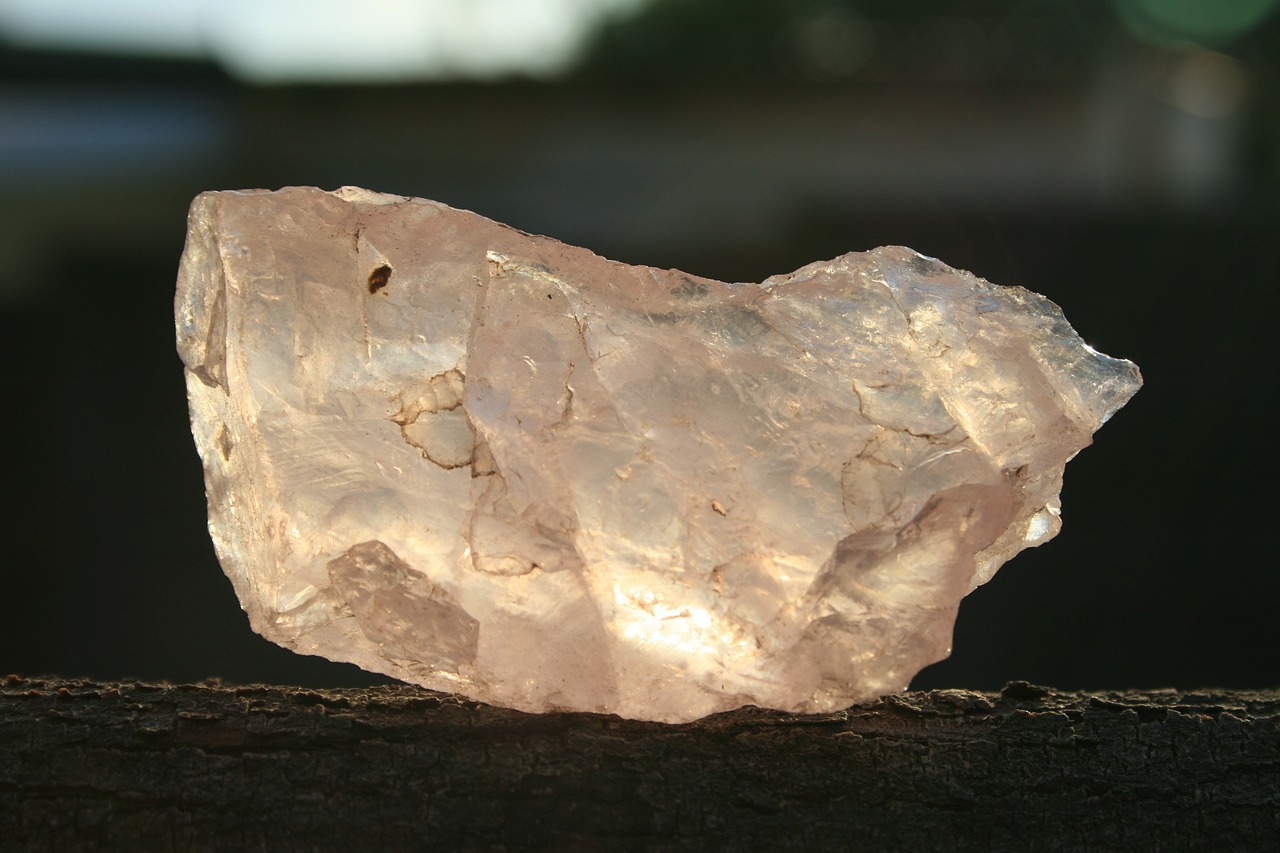
Rose quartz is a specific mineral variety of crystalline quartz that is characterized by its soft pinkish hue. The particular shade of rose quartz is due to trace amounts of titanium, manganese, iron, or dumortierite embedded in its crystalline structure.
Despite being one of the least common versions of quartz, rose quartz is still commonly found in many places around the world, mostly forming from thermal vents, pegmatite, and other igneous rocks
Rose quartz is a common commodity the world over and one of the most encountered lapidary materials. The pink hue of rose quartz is seen as gentle and comforting, so it is often used to make jewelry, tumbled stones, or other figures. It is commonly associated with the month of January, along with garnet.
Rose quartz beads dating back to 7000BC have been found in what is now modern day Iraq, indicating that ancient Mesopotamians used the material as a decorative accessory. Records of rose quartz usage are also found with the ancient Egyptians and Assyrians, as well as the Romans, who used the stone to signify ownership. Ancient natural philosophers, such as Pliny the Elder, thought that quartz was actually a form of permanently frozen ice as it was cool to the touch and refracted light in a similar fashion.
Large-scale quartz manufacturing began in the mid 19th century after quartz was discovered to have desirable industrial properties. By the 1940s, the entire electronics industry in the United States relied on quartz which led to attempts to synthesize the material in labs. Now, virtually all the quartz that is used in electronic devices is synthetically grown in a lab.
Today, the majority of rose quartz is mined from the countries of Brazil, South Africa, Madagascar, and India. Rose quartz has also been successfully synthesized in the lab but due to its easy procurement and natural abundance, synthetic rose quartz is not present in the market in large quantities.
Properties of Rose Quartz
Like all species of quartz, rose quartz is a mineral composed primarily of silicon dioxide (SiO2) molecules arranged in a tetrahedral lattice-structure. Also like all species of quartz, the crystalline structure of rose quartz comes in two chiral varieties; a normal “right-hand” structure and “left-hand” structure that spontaneously forms under high temperatures. Roe quartz typically forms at about 400-700°C so unlike other kinds of quartz that grow from a liquid solution, rose quartz grows from a supercritical gas. Due to its particular molecular structure, rose quartz is a piezoelectric material, meaning that one can accumulate an electric charge in a rose quartz by applying mechanical stress. Piezoelectric materials have a number of useful applications from cigarette lighters, microphones, solar cells, and nanotechnology.
There is still some scientific debate over what causes the specific hue of rose quartz. The pinkish color of rose quartz had commonly been attributed to the presence of rutile titanium (TiO2) embedded in the crystalline structure. In 1987, 2 researchers from the University of Missouri-Columbia Ken Appin and Brian Hicks conducted an experiment in which they dissolved portions of a rose quartz sample in hydrofluoric acid. As the acid slowly ate away the silicon dioxide, it left behind extremely thin pink fibers; fibers the same color as the rose quartz. X-ray diffraction and mass spectrometry confirmed that the fibers were a boro-silicate material known as dumortierite. Appin and Hicks took this as evidence that dumortierite is responsible for the color the star-like reflective patterns in rose quartz, a property known as asterism.
More recently though, a team of researchers at Caltech have extracted fibrous rose-colored crystals of a material that is related to, but apparently not identical to dumortierite. This material will lose its pinkish color and turn white at about 500°C but can be put in a reducing atmosphere to regain its color. This material makes up ~0.15% of the total weight of rose quartz.
The particular orientation of these fibers allow visible light to be absorbed along two distinct wavelengths; a property characteristic of a dichroic material. Light with different polarizations gets absorbed by the material at different rates. This indicates that the fibers responsible for diffracting the light are oriented in a preferred direction rather than randomly arranged. It is thought that expansion of heated rose quartz during its formation can cause the fibrous particulates to align in a particular direction.
Although commonly confused for pink quartz, rose quartz is its own distinct entity. Rose quartz, unlike pink quartz, is not affected by light and does not form crystals. The color of pink quartz is due to a different mixture of minerals as well.
Famous Rose Quartz Formations
There are fewer famous rose quartz formation or sculptures than other variety of quartz. This is because rose quartz does not typically form into as neat of a crystalline structure as other varieties of quartz. Rose quartz is also lightly hued, meaning the larger the gemstone the more difficult it is to see the quartz’s pink color, so it is rarely chosen for large pieces of jewelry.
That being said, there are a handful of spectacular rose quartz pieces that are well known. La Madonna Rosa is a famous rose quartz formation that was discovered by Brazilian miners in the town of Minas Gerais in the 1950s. The gemstone is about 15 in. tall and 8 in. wide. It sold for a whopping $662, 500 at an auction in 2013.
Another famous rose quartz piece from Minas Gerais is the “Van Allen Belt” specimen. Similar to La Madonna Rosa, The Van Allen Belt Specimen consist of a central core of smoky quartz surrounded by a belt of brilliant rose quartz. It is currently on display at The Janet Annenberg Hooker Hall of Geology, Gems, and Minerals at the Smithsonian Museum in Washington, D.C.









